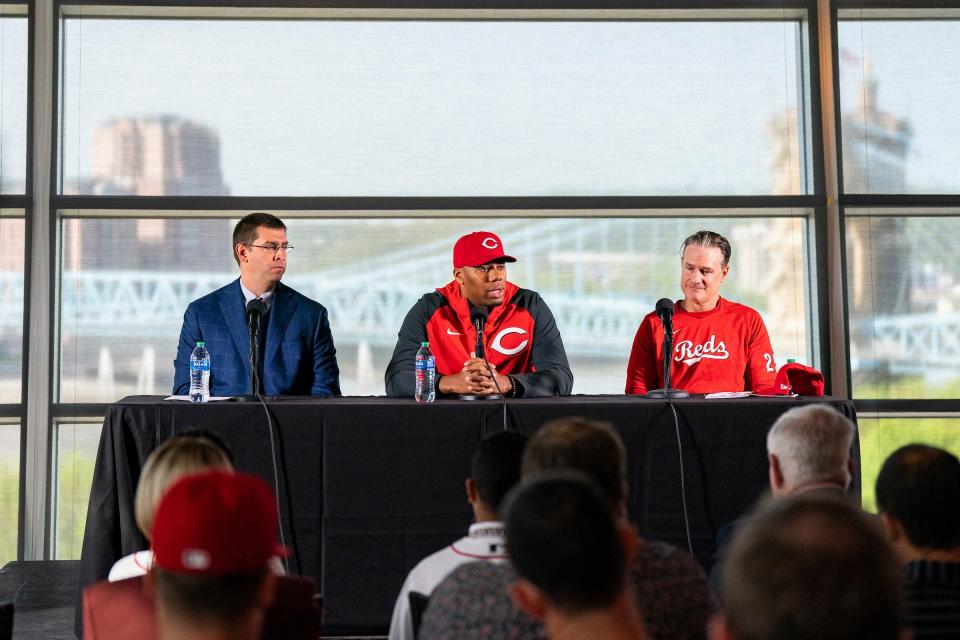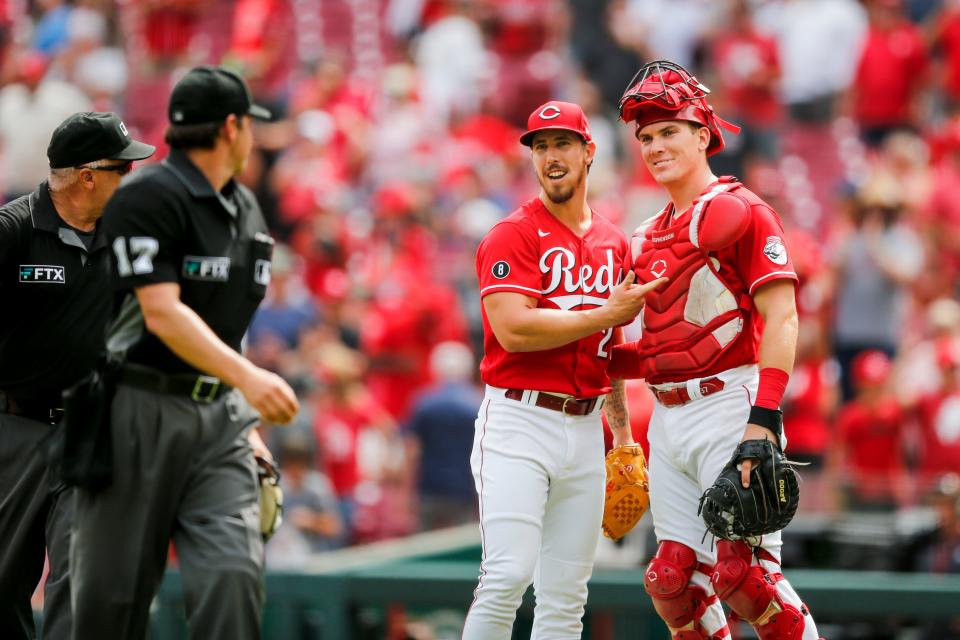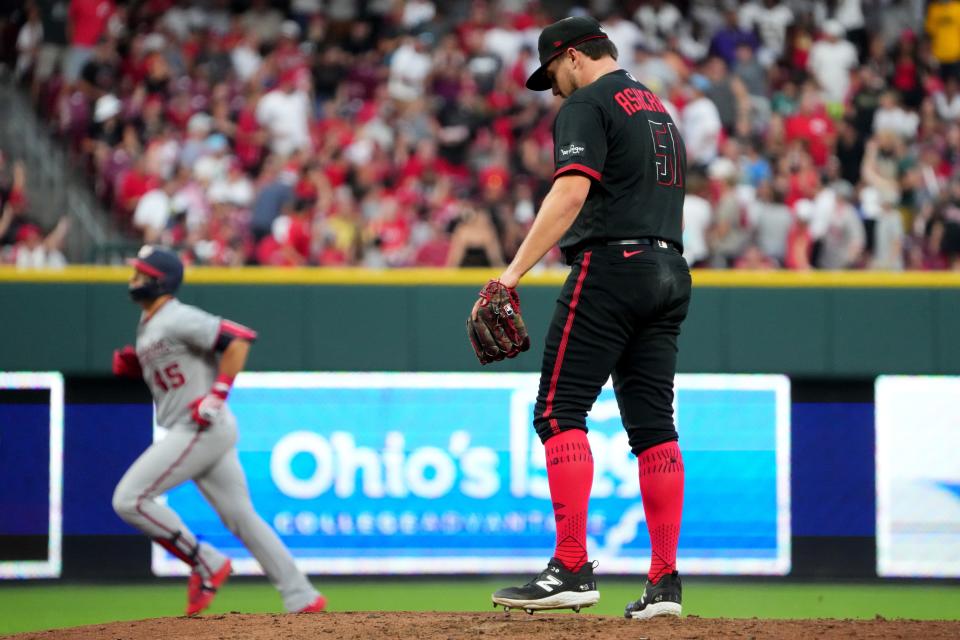How Cincinnati Reds hope to avoid losing NL Central after losing trade deadline to rivals

Cincinnati Reds general manager Nick Krall vowed “we’re leaving no stone unturned” in the days leading up to the Aug. 1 trade deadline.
Whatever he may have meant by that, at the end of the big day all it meant was the Reds were left holding a big bag of rocks while the other contenders in the National League Central filled key roster needs for the final two-month stretch drive.
Maybe Krall will come out looking like a genius when Hunter Greene and Nick Lodolo lead this team on a torrid September finish after they return from the injured list in the next few weeks. After all, it’s hard to quibble with any of the trades he made last year once ownership forced him into selloff mode before the season began.
But the hardest part of any competitive rebuild is the actual “competitive” and “build” part once the teardown and prospect-acquisition is done.
Reds Nationals With a special swing, Elly De La Cruz shows what he’s working on
Reds Nationals Reds waste bases-loaded chance in a loss to the Nationals
Reds lineups Why Cincinnati Reds’ David Bell plans to keep slumping Elly De La Cruz in leadoff spot
That’s especially true once the young talent starts to show it's ready to win.
Which means Krall took a big risk when he failed to do more than add journeyman lefty Sam Moll as a depth piece for one of the most overworked bullpens in the majors.
Sources say he had talks with the Chicago White Sox for the pitchers they eventually traded, including starters Lance Lynn and Lucas Giolito. They checked in with the Tigers, who shopped Eduardo Rodriguez (who exercised no-trade rights to nix a trade to the Los Angeles Dodgers) and traded Michael Lorenzen (the former Red).

Even after the deadline, the Reds offered to sign former Miami Marlins and Colorado Rockies starter Jose Urena, who was released after the deadline by the Nationals, to a minor-league deal before he reached a similar agreement with the White Sox.
What we know for now is that Krall lost the trade deadline to the Chicago Cubs and especially to the Milwaukee Brewers — who boosted a sagging lineup with Carlos Sanatana and Mark Canha and added an effective, veteran left-hander (Andrew Chafin) to an already good bullpen.
And until that dream finish for Greene and Lodolo materialize, the Reds may have lost the NL Central in the process.
That’s not a reaction to the four straight games they’ve lost since the deadline to knock them out of first place — including a tough, late-inning home loss to the deadline-seller Washington Nationals on Friday night.
That’s an assessment based on four months of injuries and underperformance by the rotation that persisted even as the winning began in May and June — a rotation that had the second-worst ERA (5.21) in the National League at the deadline.
Rival evaluators and executives talked for weeks about how impressive the Reds’ surge was considering the state of their pitching, and the Reds had scouts at every ballpark at which sellers with pitchers were playing.
Even in a wide-ranging conversation before the All-Star game about the approaching deadline, Brewers ace Corbin Burnes reacted to the idea that the Reds might get a boost by adding a starting pitcher.
“I think they need a lot more pitching than just maybe one starter,” Burnes said.
Since then, Reds pitchers such as Graham Ashcraft seemed to take that personally. He’s 3-1 with a 2.05 ERA in his last seven starts — including six dominant innings against Burnes and the Brewers in a 1-0 loss out of the break.

But Burnes wasn’t wrong.
And the chance to win when a path to October opens with a group that shows it might be capable of something greater than the sum of its parts doesn’t come along very often in major-league sports. (Remember, that 12-game winning streak was something that not even the Big Red Machine or Lou Piniella’s Nasty Boys ever pulled off.)
So the front office can hold onto all that duplication of talent in the system and talk about “sustainability” in refusing to part with enough necessary prospects — yes, even good ones — to land the veteran, rent-a-starter that might have eased the burden on the bullpen until Greene and/or Lodolo return, and stretch the pitching staff’s quality of depth even after for the duration.
And the front office and players can rightfully express all the faith they have in each other and the wealth of talent on a very, very young roster.
But many of the best players during the surge into contention have never played a full six months in a professional season, much less the big leagues — much, much less the final month of it in the heat of a pennant race.
And if you want to talk about sustainability, fine.
But even assuming every bit of this 2023 success with all this young talent is the real, long-term deal, don’t make the mistake of assuming that means the Reds will be in this position again next year by bringing back the same group. Or the next year.
Maybe they will.
Or maybe the Cubs will spend another quarter-billion dollars on free agents over the winter, and maybe the Brewers’ pitching will be even better next year. And maybe the Reds win even more games next year but wind up in third place.
The point isn’t that the Reds won’t be good, or even better.
The point is the opportunity to strike was there for a team that hasn’t won a division in 11 years, a playoff series in 28 years or a playoff game beyond a division series since 1990 when they won the whole thing.
And for those who have been around long enough to remember 33 years ago, how many expected that team to be the Reds’ first World Series winner since 1976 — the only one to get there in what’s closing in on five decades?
Consider what’s happened since Krall stood essentially pat at the trade deadline:
The Reds were outscored 36-15 in their next two games, with the rotation providing a scant 3, 4 and 4 1/3 innings in the first three after the deadline.
One of those starters, Ben Lively, landed back on the injured list with a recurring pec injury, creating an opening that meant a 13th big-league debut for the Reds this season with hard-throwing prospect Lyon Richardson’s scheduled debut Sunday against the Nationals.
Meanwhile, the Brewers planned to bring one of the best starters in the majors in recent years, Brandon Woodruff, back from the IL to rejoin the rotation Sunday for the stretch run.
That doesn’t mean the Reds don’t have the in-house means or will to win the division.
But the Brewers, who beat the Reds in 10 of 13 meetings this season, definitely got better at the deadline — and yet again with Woodruff’s return.
The Cubs also did more to help their club at the deadline with a trade Tuesday for third-baseman Jeimer Candelario, who then raked Reds pitching for eight hits and a walk in 10 trips to the plate during those two blowouts.
The Reds don’t have to play the Brewers again this year, so there’s that. The Cubs have six left against the Brewers (including the last three of the year) and four against the Reds, all in September at Great American Ball Park. (Reds are 5-4 against the Cubs).
Aside from that, the strength of schedules for all three down the stretch are remarkably similar.
Krall expressed belief in his team after the deadline, reiterating a point he made a few days before: “I want to make sure that we’re building this for sustainability, not just for a one-year playoff run.”
He didn’t have to sell the farm to get more than a depth reliever to help a team that more than earned reinforcements.
The prices were high in a seller’s market for most of the trading period, but middle-of-the-rotation-level rent-a-starter Lorenzen cost the Phillies only a decent Class A infielder on nobody’s top-100 list, Hao-Yen Lee.
Lee was the No. 5-ranked prospect in what MLB Pipeline considered a bottom-10 farm system.
Could the Reds — a top-five system — have done something similar with prospect ranked lower in their system?
Should they have? The next two months might answer that question with more certainty.
The next two years almost certainly will.
“It speaks volumes that Nick is saying, ‘I believe in the guys that are in this clubhouse,’ “ reliever Alex Young said. “I guess we’ll see what happens. But I feel confident still.
“It’s basically come down to a three-team race,” he added. “Obviously, no one thought we were going to be here.
“So it’s just us vs. the world at this point.”
This article originally appeared on Cincinnati Enquirer: Did Cincinnati Reds lose NL Central when they lost the trade deadline?

